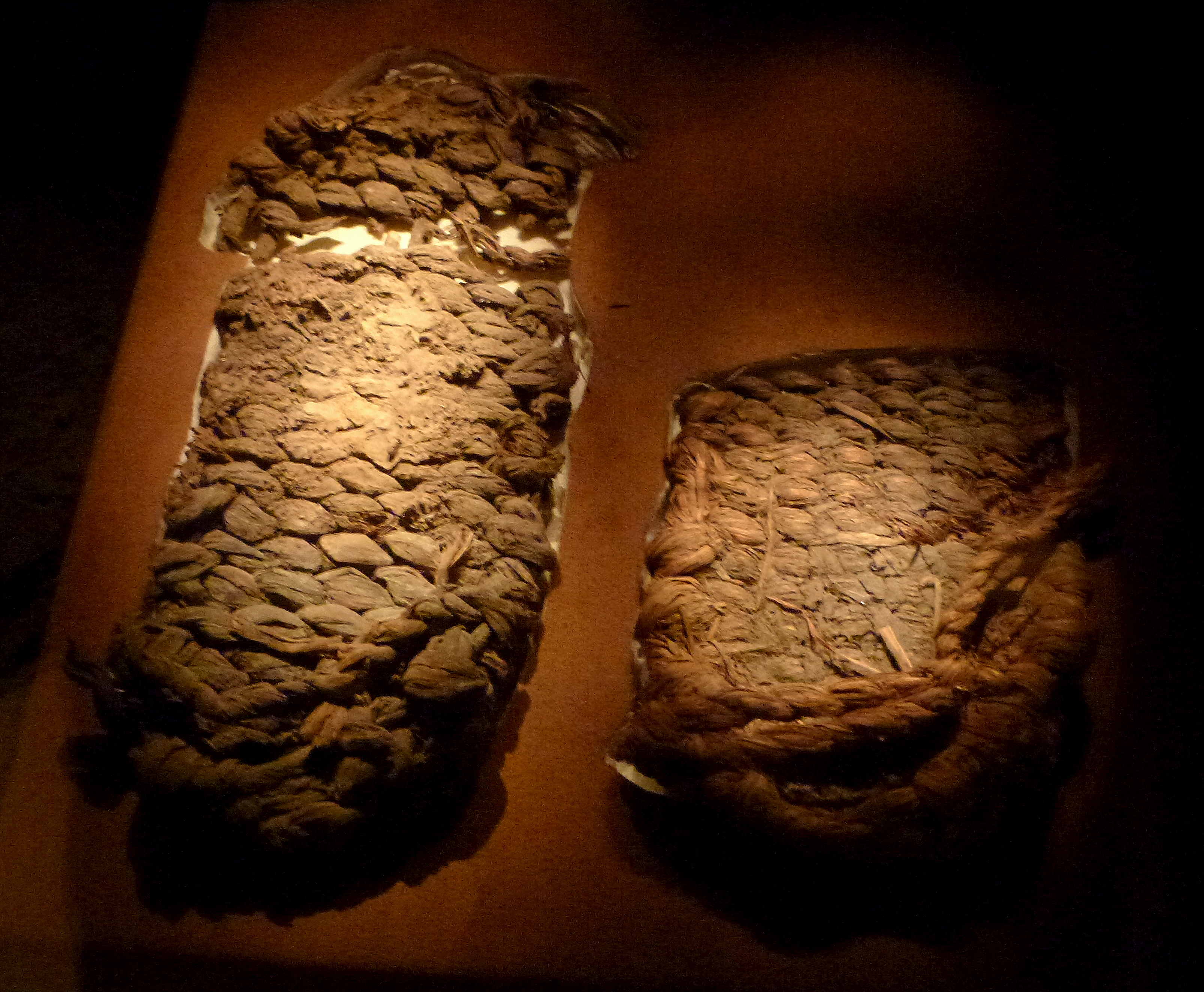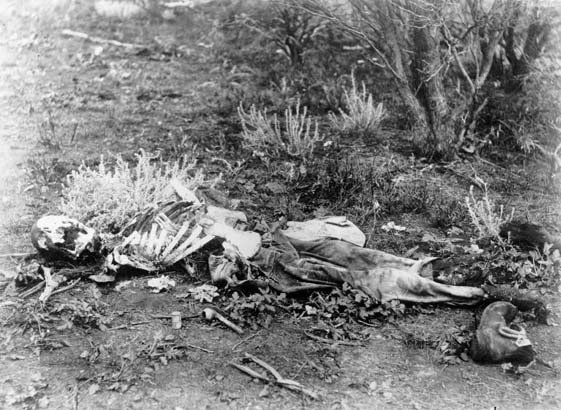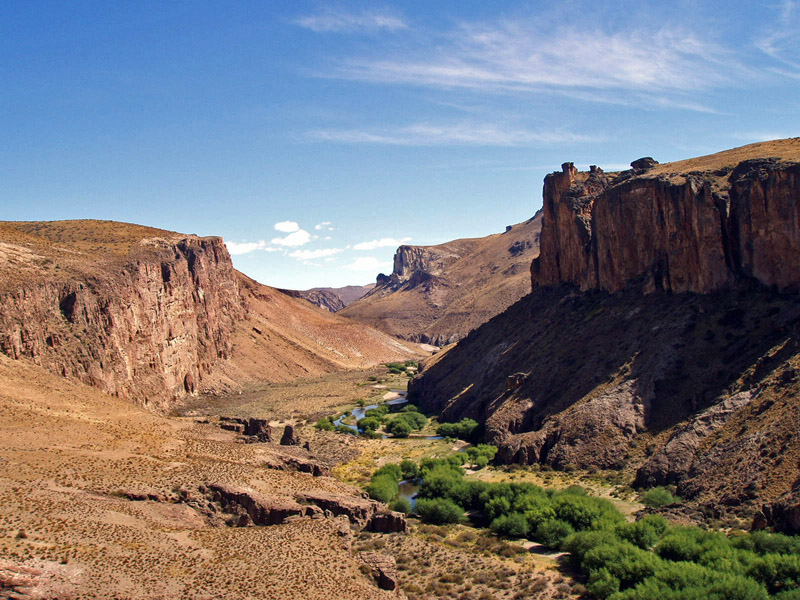|
Buhl Woman
Buhla is the name for a skeleton of a prehistoric ( Paleo-Indian) woman found in a quarry near Buhl, Idaho, United States, in January 1989. The skeleton's age has been estimated by radiocarbon dating at 10,675 ± 95 BP, which confirms this as one of the oldest sets of human remains found in the Americas. The discovery was made by a quarry worker when he noticed what was found to be a thigh bone in the screen of a rock crusher. The nearly complete skeleton was subsequently unearthed nearby. Scientific analysis An analysis of the skeleton showed that Buhla was between 17 and 21 years old, tall, and was in general good health. The cause of death could not be determined. Carbon and nitrogen isotope analysis of Buhla's bone collagen suggests that Buhla ate largely bison and elk, with occasional salmon and other fish. The wear patterns in her teeth indicated that the meat was cooked before eating. Her teeth showed signs of heavy wear caused by sand or grit, wear that would be consis ... [...More Info...] [...Related Items...] OR: [Wikipedia] [Google] [Baidu] |
Fort Hall Indian Reservation
The Fort Hall Reservation is a Native American reservation of the federally recognized Shoshone- Bannock Tribes (Shoshoni language: Pohoko’ikkateeCrum, B., Crum, E., & Dayley, J. P. (2001). Newe Hupia: Shoshoni Poetry Songs. University Press of Colorado. Pg. 20doi.org/10.2307/j.ctt46nz00/ref>) in the U.S. state of Idaho. This is one of five federally recognized tribes in the state. The reservation is located in southeastern Idaho on the Snake River Plain about north and west of Pocatello. It comprises of land area in four counties: Bingham, Power, Bannock, and Caribou. To the east is the Portneuf Range; both Mount Putnam and South Putnam Mountain are located on the Fort Hall Reservation. Founded under an 1868 treaty, the reservation is named for Fort Hall, a trading post in the Portneuf Valley that was established by European Americans. It was an important stop along the Oregon and California trails in the middle 19th century. A monument on the reservation marks the ... [...More Info...] [...Related Items...] OR: [Wikipedia] [Google] [Baidu] |
Peñon Woman
Peñon woman or Peñon Woman III is the name for the human remains, specifically a skull, of a Paleo-Indian woman found by an ancient lake bed in Pueblo Peñón de los Baños in Mexico City in 1959. Discovery Peñon Woman III was found on an island in the middle of Lake Texcoco.Grattan and Torrence 91 The skeleton's age has been estimated by radiocarbon dating by Silvia Gonzalez of Liverpool John Moores University."The New World may be far older than it originally seemed." ''The Economist.'' 14 July 2005. Retrieved 15 April 2012. Her 14C date is 10,755±55 years (12,705 cal years) BP. She is one of the oldest human remains found in the . Gonzalez theo ... [...More Info...] [...Related Items...] OR: [Wikipedia] [Google] [Baidu] |
Paisley Caves
The Paisley Caves or the Paisley Five Mile Point Caves complex is a system of eight caves in an arid, desolate region of south-central Oregon, United States north of the present-day city of Paisley, Oregon. The caves are located in the Summer Lake basin at elevation and face west, carved into a ridge of Miocene and Pliocene era basalts mixed with soft volcanic tuffs and breccias by Pleistocene-era waves from Summer Lake. One of the caves may contain archaeological evidence of the oldest definitively-dated human presence in North America. The site was first studied by Luther Cressman in the 1930s. Scientific excavations and analysis in the Paisley Caves since 2002 have uncovered substantial new discoveries, including subfossil human coprolites with the oldest DNA evidence of human habitation in North America, various artifacts, and animal remains. The DNA was radiocarbon dated to 14,300 BP or roughly 12,000 BCE. The caves were added to the National Register of Historic Places ... [...More Info...] [...Related Items...] OR: [Wikipedia] [Google] [Baidu] |
Marmes Rockshelter
The Marmes Rockshelter (also known as (45-FR-50)) is an archaeological site first excavated in 1962, near Lyons Ferry Park and the confluence of the Snake and Palouse Rivers, in Franklin County, southeastern Washington. This rockshelter is remarkable in the level of preservation of organic materials, the depth of stratified deposits, and the apparent age of the associated Native American human remains. The site was discovered on the property of Roland Marmes, and was the site of the oldest human remains in North America at that time. In 1966, the site became, along with Chinook Point and the American and English Camps on San Juan Island, the first National Historic Landmarks listed in Washington. In 1969, the site was submerged in water when a levee protecting it from waters rising behind the then newly constructed Lower Monumental Dam, which was down the Snake River, failed to hold back water that leaked into the protected area through gravel under the soil, creating Lake H ... [...More Info...] [...Related Items...] OR: [Wikipedia] [Google] [Baidu] |
Luzia Woman
Luzia Woman () is the name for an Upper Paleolithic period skeleton of a Paleo-Indian woman who was found in a cave in Brazil. Some archaeologists originally thought the young woman may have been part of a migratory wave of immigrants prior to the ancestors of today's Amerindians, though DNA and other evidence has shown this to be improbable. The 11,500-year-old skeleton was found in a cave in the Lapa Vermelha archeological site in Pedro Leopoldo, in the Greater Belo Horizonte region of Brazil, in 1974 by archaeologist Annette Laming-Emperaire. The nickname ''Luzia'' was chosen in homage to the Australopithecus fossil Lucy. The fossil was kept at the National Museum of Brazil, where it was shown to the public until it was fragmented during a fire that destroyed the museum on September 2, 2018. On October 19, 2018, it was announced that most of Luzia's remains were identified from the Museu Nacional debris, which allowed them to rebuild part of her skeleton. History Luzia was ... [...More Info...] [...Related Items...] OR: [Wikipedia] [Google] [Baidu] |
Kwäday Dän Ts'ìnchi
Kwäday Dän Tsʼìnchi (), or Canadian Ice Man, is a naturally mummified body found in Tatshenshini-Alsek Provincial Park in British Columbia, Canada, by a group of hunters in 1999. Kwäday Dän Tsʼìnchi means "Long Ago Person Found" in Southern Tutchone, and is pronounced in that language. Radiocarbon dating of artifacts found with the body placed the age of the body at between 300 and 550 years. The find was comparable in condition and scientific value to Ötzi the Iceman, remains dating to 3300 BC that were found in the Ötztal Alps in 1991. DNA testing of more than 240 volunteers from the local Champagne and Aishihik First Nations revealed 17 persons who are related to the ice man through their direct maternal line. They were excited to have their deep connections to the area affirmed. Discovery Three sheep hunters, Bill Hanlon, Warren Ward and Mike Roche, discovered a number of artifacts and a human body in a melting glacier while hunting near the Yukon border on J ... [...More Info...] [...Related Items...] OR: [Wikipedia] [Google] [Baidu] |
Kennewick Man
Kennewick Man and Ancient One are the names generally given to the skeletal remains of a prehistoric Paleoamerican man found on a bank of the Columbia River in Kennewick, Washington, on July 28, 1996. It is one of the most complete ancient skeletons ever found. Radiocarbon tests on bone have shown it to date from 8,900 to 9,000 calibrated years before present,Preston, Douglas (September 2014)"The Kennewick Man Finally Freed to Share His Secrets" '' Smithsonian''. Retrieved November 8, 2014. but it was not until 2013 that ancient DNA analysis techniques had improved enough to shed light on the remains. The discovery led to controversy among scientists as well as Native American tribes for more than a decade. The Umatilla people and other tribes demanded that the remains be returned for reburial under the federal Native American Graves Protection and Repatriation Act (NAGPRA). The law was designed to return human remains and cultural objects which had long been unlawfully obt ... [...More Info...] [...Related Items...] OR: [Wikipedia] [Google] [Baidu] |
List Of Unsolved Deaths
This list of unsolved deaths includes well-known cases where: * The cause of death could not be officially determined. * The person's identity could not be established after they were found dead. * The cause is known, but the manner of death (homicide, suicide, accident, overdosing) could not be determined. * Different official investigations have come to different conclusions. Cases where there are unofficial alternative theories about deaths – the most common theory being that the death was a homicide – can be found under: Death conspiracy theories. Unsolved murders Unsolved deaths Ancient * Cleopatra (39), the last ruler of Ptolemaic Egypt, is believed to have died in August 30 BCE in Alexandria. According to popular belief, Cleopatra committed suicide by allowing an asp (Egyptian cobra) to bite her. According to Greek and Roman historians, Cleopatra poisoned herself using either a toxic ointment or sharp implement such as a hairpin. Primary source accounts are deriv ... [...More Info...] [...Related Items...] OR: [Wikipedia] [Google] [Baidu] |
Fort Rock Cave
Fort Rock Cave was the site of the earliest evidence of human habitation in the US state of Oregon before the excavation of Paisley Caves. Fort Rock Cave featured numerous well-preserved sagebrush sandals, ranging from 9,000 to 13,000 years old. The cave is located approximately west of Fort Rock near Fort Rock State Natural Area in Lake County. Fort Rock Cave was declared a National Historic Landmark in 1961, and added to the National Register of Historic Places in 1966.. The cave was found on Reub Long's ranch. It was formerly known as Menkenmaier Cave and Cow Cave. Description Fort Rock Cave sits in the Fort Rock formation, and shares geological similarities to its surroundings, with presence of Hayes Butte basalt, and exposed Pliocene-era lava. Additionally, there is pumice and ash from Mount Mazama (deposited by the explosion forming Crater Lake about 7600 years ago). The opening of the cave is approximately 70 feet across, with a depth of near 60 feet, making it the l ... [...More Info...] [...Related Items...] OR: [Wikipedia] [Google] [Baidu] |
Forensic Anthropology
Forensic anthropology is the application of the anatomical science of anthropology and its various subfields, including forensic archaeology and forensic taphonomy, in a legal setting. A forensic anthropologist can assist in the identification of deceased individuals whose remains are decomposed, burned, mutilated or otherwise unrecognizable, as might happen in a plane crash. Forensic anthropologists are also instrumental in the investigation and documentation of genocide and mass graves. Along with forensic pathologists, forensic dentists, and homicide investigators, forensic anthropologists commonly testify in court as expert witnesses. Using physical markers present on a skeleton, a forensic anthropologist can potentially determine a person's age, sex, stature, and race. In addition to identifying physical characteristics of the individual, forensic anthropologists can use skeletal abnormalities to potentially determine cause of death, past trauma such as broken bones ... [...More Info...] [...Related Items...] OR: [Wikipedia] [Google] [Baidu] |
Cueva De Las Manos
Cueva de las Manos (Spanish for Cave of the Hands or Cave of Hands) is a cave and complex of rock art sites in the province of Santa Cruz, Argentina, south of the town of Perito Moreno. It is named for the hundreds of paintings of hands stenciled, in multiple collages, on the rock walls. The art was created in several waves between 7,300 BC and 700 AD, during the Archaic period of pre-Columbian South America. The age of the paintings was calculated from the remains of bone pipes used for spraying the paint on the wall of the cave to create the artwork, radiocarbon dating of the artwork, and stratigraphic dating. The site is considered by some scholars to be the best material evidence of early South American hunter-gatherer groups. Argentine surveyor and archaeologist Carlos J. Gradin and his team conducted the most important research on the site in 1964, when they began excavating sites during a 30-year study of cave art in and around Cueva de las Manos. The site is a Na ... [...More Info...] [...Related Items...] OR: [Wikipedia] [Google] [Baidu] |





